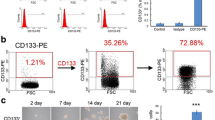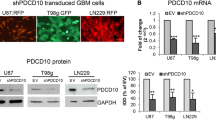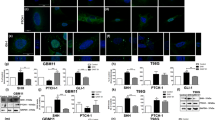Abstract
Recent studies suggest that cancer stem cells (CSCs) are responsible for cancer resistance to therapies. We therefore investigated how glioblastoma-derived CSCs respond to the treatment of tumor necrosis factor-related apoptosis-inducing ligand (TRAIL). Neurospheres were generated from glioblastomas, characterized for CSC properties including self-renewal, cell differentiation and xenograft formation capacity, and analyzed for TRAIL-induced apoptosis, CASP8 genomic status, and caspase-8 protein expression. The neurosphere NSC326 was sensitive to TRAIL-induced apoptosis as evidenced by cell death and caspase-8, -3, and -7 enzymatic activities. In contrast, however, the neurosphere NSC189 was TRAIL-resistant. G-banding analysis identified five chromosomally distinguishable cell populations in the neurospheres. Fluorescence in situ hybridization revealed the variation of chromosome 2 copy number in these populations and the loss of CASP8 locus in 2q33-34 region in a small set of cell populations in the neurosphere. Immunohistochemistry of NSC189 cell blocks revealed the lack of caspase-8 protein in a subset of neurosphere cells. Western blotting and immunohistochemistry of human glioblastoma tumors demonstrated the expression of caspase-8 protein in the vast majority of the tumors as compared to normal human brain tissues that lack the caspase-8 expression. This study shows heterogeneity of glioblastomas and derived CSCs in the genomic status of CASP8, expression of caspase-8, and thus responsiveness to TRAIL-induced apoptosis. Clinic trials may consider genomic analysis of the cancer tissue to identify the genomic loss of CASP8 and use it as a genomic marker to predict the resistance of glioblastomas to TRAIL apoptosis pathway-targeted therapies.








Similar content being viewed by others
References
Bellail AC, Tse MC, Song JH et al (2010) DR5-mediated DISC controls caspase-8 cleavage and initiation of apoptosis in human glioblastomas. J Cell Mol Med 14:1303–1317
Johnstone RW, Frew AJ, Smyth MJ (2008) The TRAIL apoptotic pathway in cancer onset, progression and therapy. Nat Rev Cancer 8:782–798
Bellail AC, Qi L, Mulligan P, Chhabra V, Hao C (2009) TRAIL agonists on clinical trials for cancer therapy: the promises and the challenges. Rev Recent Clin Trials 4:34–41
Bao S, Wu Q, McLendon RE et al (2006) Glioma stem cells promote radioresistance by preferential activation of the DNA damage response. Nature 444:756–760
Liu G, Yuan X, Zeng Z et al (2006) Analysis of gene expression and chemoresistance of CD133+ cancer stem cells in glioblastoma. Mol Cancer 5:67
Ignatova TN, Kukekov VG, Laywell ED, Suslov ON, Vrionis FD, Steindler DA (2002) Human cortical glial tumors contain neural stem-like cells expressing astroglial and neuronal markers in vitro. Glia 39:193–206
Reynolds BA, Weiss S (1992) Generation of neurons and astrocytes from isolated cells of the adult mammalian central nervous system. Science 255:1707–1710
Singh SK, Clarke ID, Terasaki M et al (2003) Identification of a cancer stem cell in human brain tumors. Cancer Res 63:5821–5828
Singh SK, Hawkins C, Clarke ID et al (2004) Identification of human brain tumour initiating cells. Nature 432:396–401
Galli R, Binda E, Orfanelli U et al (2004) Isolation and characterization of tumorigenic, stem-like neural precursors from human glioblastoma. Cancer Res 64:7011–7021
Yuan X, Curtin J, Xiong Y et al (2004) Isolation of cancer stem cells from adult glioblastoma multiforme. Oncogene 23:9392–9400
Lee J, Kotliarova S, Kotliarov Y et al (2006) Tumor stem cells derived from glioblastomas cultured in bFGF and EGF more closely mirror the phenotype and genotype of primary tumors than do serum-cultured cell lines. Cancer Cell 9:391–403
Bao S, Wu Q, Sathornsumetee S et al (2006) Stem cell-like glioma cells promote tumor angiogenesis through vascular endothelial growth factor. Cancer Res 66:7843–7848
Li Z, Bao S, Wu Q et al (2009) Hypoxia-inducible factors regulate tumorigenic capacity of glioma stem cells. Cancer Cell 15:501–513
Beier D, Hau P, Proescholdt M et al (2007) CD133(+) and CD133(−) glioblastoma-derived cancer stem cells show differential growth characteristics and molecular profiles. Cancer Res 67:4010–4015
Laks DR, Masterman-Smith M, Visnyei K et al (2009) Neurosphere formation is an independent predictor of clinical outcome in malignant glioma. Stem Cells 27:980–987
Kanamori M, Kawaguchi T, Nigro JM et al (2007) Contribution of Notch signaling activation to human glioblastoma multiforme. J Neurosurg 106:417–427
Bar EE, Chaudhry A, Lin A et al (2007) Cyclopamine-mediated hedgehog pathway inhibition depletes stem-like cancer cells in glioblastoma. Stem Cells 25:2524–2533
Jiang H, Gomez-Manzano C, Aoki H et al (2007) Examination of the therapeutic potential of Delta-24-RGD in brain tumor stem cells: role of autophagic cell death. J Natl Cancer Inst 99:1410–1414
Song JH, Song DK, Pyrzynska B, Petruk KC, Van Meir EG, Hao C (2003) TRAIL triggers apoptosis in malignant glioma cells through extrinsic and intrinsic pathways. Brain Pathol 13:539–553
Ishii N, Maier D, Merlo A et al (1999) Frequent co-alterations of TP53, p16/CDKN2A, p14ARF, PTEN tumor suppressor genes in human glioma cell lines. Brain Pathol 9:469–479
Hao C, Parney IF, Roa WH, Turner J, Petruk KC, Ramsay DA (2002) Cytokine and cytokine receptor mRNA expression in human glioblastomas: evidence of Th1, Th2 and Th3 cytokine dysregulation. Acta Neuropathol (Berl) 103:171–178
Hao C, Beguinot F, Condorelli G et al (2001) Induction and intracellular regulation of tumor necrosis factor-related apoptosis-inducing ligand (TRAIL) mediated apotosis in human malignant glioma cells. Cancer Res 61:1162–1170
Kischkel FC, Kioschis P, Weitz S, Poustka A, Lichter P, Krammer PH (1998) Assignment of CASP8 to human chromosome band 2q33→q34 and Casp8 to the murine syntenic region on chromosome 1B-proximal C by in situ hybridization. Cytogenet Cell Genet 82:95–96
Ashkenazi A, Pai RC, Fong S et al (1999) Safety and antitumor activity of recombinant soluble Apo2 ligand. J Clin Invest 104:155–162
Roth W, Isenmann S, Naumann U et al (1999) Locoregional Apo2L/TRAIL eradicates intracranial human malignant glioma xenografts in athymic mice in the absence of neurotoxicity. Biochem Biophys Res Commun 265:479–483
Pollack IF, Erff M, Ashkenazi A (2001) Direct stimulation of apoptotic signaling by soluble Apo2l/tumor necrosis factor-related apoptosis-inducing ligand leads to selective killing of glioma cells. Clin Cancer Res 7:1362–1369
Knight MJ, Riffkin CD, Muscat AM, Ashley DM, Hawkins CJ (2001) Analysis of FasL and TRAIL induced apoptosis pathways in glioma cells. Oncogene 20:5789–5798
Ichikawa K, Liu W, Zhao L et al (2001) Tumoricidal activity of a novel anti-human DR5 monoclonal antibody without hepatocyte cytotoxicity. Nat Med 7:954–960
Xiao C, Yang BF, Asadi N, Beguinot F, Hao C (2002) Tumor necrosis factor-related apoptosis-inducing ligand-induced death-inducing signaling complex and its modulation by c-FLIP and PED/PEA-15 in glioma cells. J Biol Chem 277:25020–25025
Bodmer JL, Holler N, Reynard S et al (2000) TRAIL receptor-2 signals apoptosis through FADD and caspase-8. Nat Cell Biol 2:241–243
Scaffidi C, Medema JP, Krammer PH, Peter ME (1997) FLICE is predominantly expressed as two functionally active isoforms, caspase-8/a and caspase-8/b. J Biol Chem 272:26953–26958
Boatright KM, Renatus M, Scott FL et al (2003) A unified model for apical caspase activation. Mol Cell 11:529–541
Chang DW, Xing Z, Capacio VL, Peter ME, Yang X (2003) Interdimer processing mechanism of procaspase-8 activation. EMBO J 22:4132–4142
Donepudi M, Mac Sweeney A, Briand C, Grutter MG (2003) Insights into the regulatory mechanism for caspase-8 activation. Mol Cell 11:543–549
Li YC, Tzeng CC, Song JH et al (2006) Genomic alterations in human malignant glioma cells associate with the cell resistance to the combination treatment with tumor necrosis factor-related apoptosis-inducing ligand and chemotherapy. Clin Cancer Res 12:2716–2729
Hopkins-Donaldson S, Bodmer JL, Bourloud KB, Brognara CB, Tschopp J, Gross N (2000) Loss of caspase-8 expression in highly malignant human neuroblastoma cells correlates with resistance to tumor necrosis factor-related apoptosis-inducing ligand-induced apoptosis. Cancer Res 60:4315–4319
Eggert A, Grotzer MA, Zuzak TJ et al (2001) Resistance to tumor necrosis factor-related apoptosis-inducing ligand (TRAIL)-induced apoptosis in neuroblastoma cells correlates with a loss of caspase-8 expression. Cancer Res 61:1314–1319
Kim HS, Lee JW, Soung YH et al (2003) Inactivating mutations of caspase-8 gene in colorectal carcinomas. Gastroenterology 125:708–715
Soung YH, Lee JW, Kim SY et al (2005) CASPASE-8 gene is inactivated by somatic mutations in gastric carcinomas. Cancer Res 65:815–821
Panner A, James CD, Berger MS, Pieper RO (2005) mTOR controls FLIPS translation and TRAIL sensitivity in glioblastoma multiforme cells. Mol Cell Biol 25:8809–8823
Panner A, Murray JC, Berger MS, Pieper RO (2007) Heat shock protein 90alpha recruits FLIPS to the death-inducing signaling complex and contributes to TRAIL resistance in human glioma. Cancer Res 67:9482–9489
Acknowledgments
We thank Diane Lawson for her technical support. This work was supported by National Institutes of Health grant CA129687 (C.H.) and Southeastern Brain Tumor Foundation research award (C.H.). C.H. was a Georgia Cancer Coalition Distinguished Scholar.
Author information
Authors and Affiliations
Corresponding author
Additional information
Ling Qi and Anita C. Bellail contributed equally to this study.
Rights and permissions
About this article
Cite this article
Qi, L., Bellail, A.C., Rossi, M.R. et al. Heterogeneity of primary glioblastoma cells in the expression of caspase-8 and the response to TRAIL-induced apoptosis. Apoptosis 16, 1150–1164 (2011). https://doi.org/10.1007/s10495-011-0645-6
Published:
Issue Date:
DOI: https://doi.org/10.1007/s10495-011-0645-6




